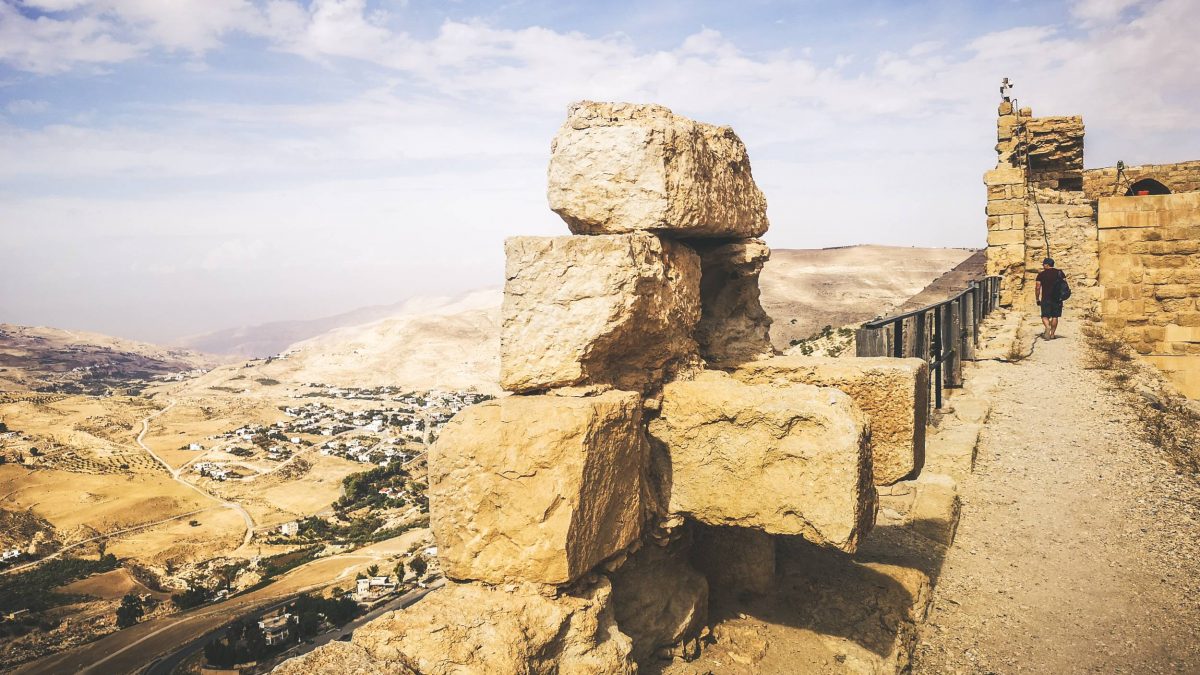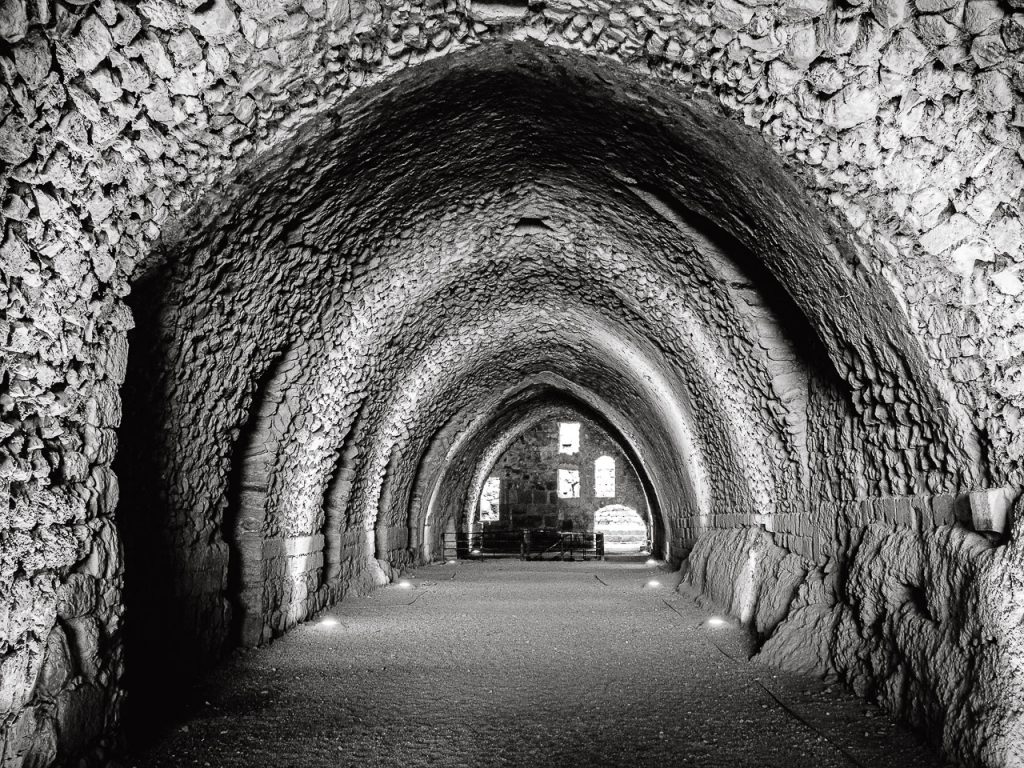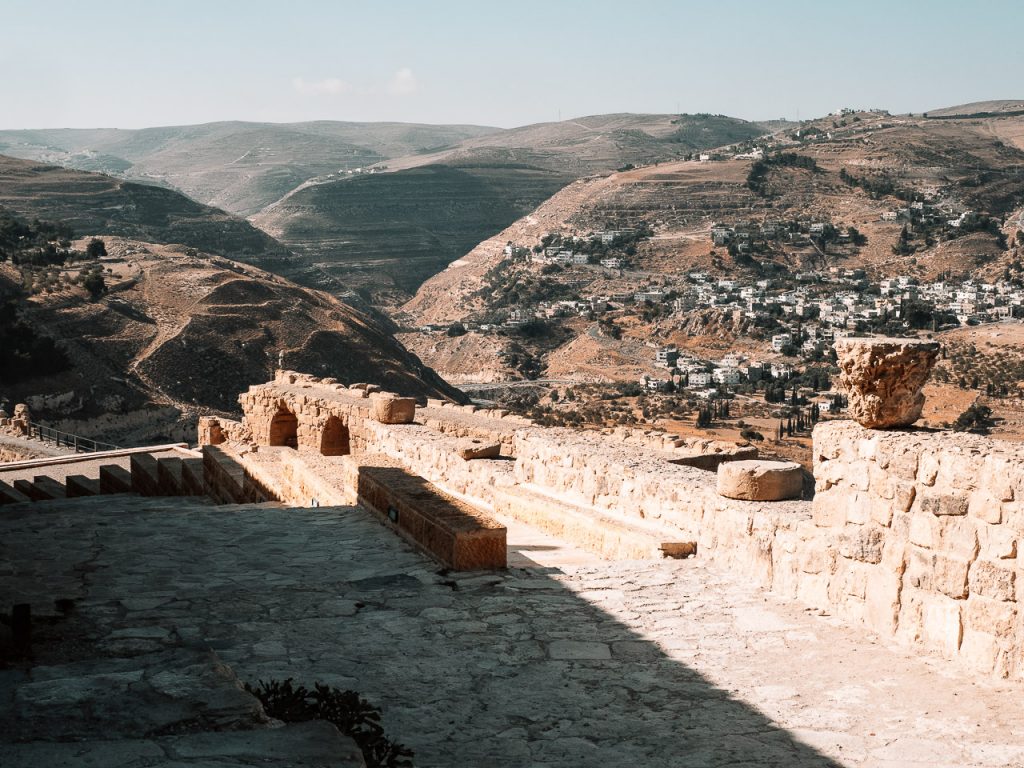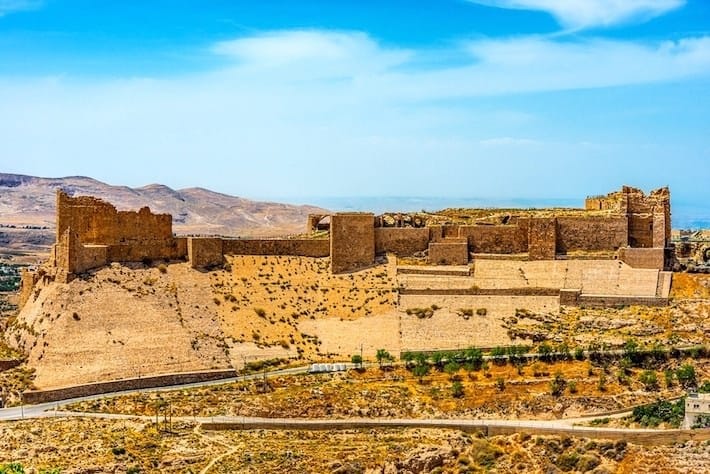Karak Castle: A Fascinating Example of Crusader Architecture
Have you ever wanted to step back in time and explore the ancient world of the Crusaders? Then look no further than Karak Castle in Jordan. This impressive fortress, located on the ancient King's Highway, was built in the 12th century and served as a stronghold for the Crusaders and a treasury and administrative centre for the Mamluk sultans. With its thick stone walls and underground structures, a tour of Karak Castle provides a unique glimpse into the fascinating world of Crusader architecture. Join me on a journey through time to explore this medieval masterpiece.

Mention of the visit to Jordan and previous blog post about Petra
During a recent visit to Jordan, we had the chance to explore the country's impressive historical sites, including the famous Petra and the lesser-known Karak Castle. If you missed our previous blog post about Petra, check it out!
Karak Castle is a fascinating example of Crusader architecture and a must-visit destination in Jordan. Located in Al Kerak, the castle was built in 1142 under the rule of Paganus, also known as Payen le Bouteiller. Its strategic location on the caravan route between Damascus and Mecca made it an important part of the Oultrejourdain dominion, which belonged to the Crusader Kingdom of Jerusalem.
The castle played a significant role in the Crusades and was repeatedly sieged by Sultan Saladin. In the 13th century, it became the stronghold of the Mamluk sultans. Throughout history, the castle's fortified tower structures blended West European Byzantine and Arab designs, making it a unique example of Crusader architecture.
Aside from its historical significance, Karak Castle offers visitors a chance to explore its dark-lit underground passageways and enjoy the spectacular views from the castle perched atop a hill. The site is open daily, but the opening hours vary depending on the season, so be sure to check ahead.
If you have time, consider visiting the other impressive castles throughout Jordan, such as Qasr Al-Kharaneh, which was likely a meeting place or hunting lodge for the region's elite built around 711 CE. Exploring these castles provides a glimpse into Jordan's rich history and is a unique experience not to be missed. [1][2]

Introduction to the topic: Karak Castle, a crusader stronghold
During a recent visit to Jordan, I had the opportunity to explore the magnificent Karak Castle. This stunning fortress is a perfect example of the impressive crusader architecture prevalent during these times. As I had previously written about Petra, visiting Karak Castle was a natural extension of my exploration of the historical wonders of Jordan.
Located in Al Kerak, Karak Castle was built in 1142 under the supervision of Paganus (Payen le Bouteiller). It was strategically constructed on a caravan route linking Mecca and Damascus, making it an important part of the Oultrejourdain dominion, an important part of the Crusader Kingdom of Jerusalem. Karak Castle was a preferred stronghold for the Mamluk sultans in the 13th century. It was characterized by a fortified-tower structure, a perfect blend of West European, Byzantine and Arab designs.
The castle's historical significance can be traced back to the repeated sieges it faced by Sultan Saladin during the Crusades. Despite facing attacks by Saladin's troops, Karak Castle stood firm and maintained its position as a significant element in the region's history. It was also an administrative centre, and its importance can be gauged from the fact that royalty treasuries were housed there. The Castle was rebuilt on several occasions, and it's north wall still has immense arched halls on two levels, which were used for both living quarters and stables.
Karak Castle's location makes it a perfect destination for tourists and historians who appreciate history and architecture's wonders. With its strategic location and impressive construction, Karak Castle is a must-visit destination for anyone who desires to delve deeper into the rich history of the Crusades and experience the unique cultural amalgamation that shaped the region's history. [3][4]

Description of the City of Al Kerak and its historical significance
Alak is a city in Jordan with a rich historical background. This city is about 140 km south of Amman and is known for its exquisite landmark, the Karak Castle. The city's name is derived from the Arabic word 'karak,' meaning fortification, referring to the city's prominent feature. Al Kerak was a vital trading hub due to its strategic position on the caravan route between Damascus and Mecca. This city played a significant role during the Crusades and was an integral part of the Oultrejourdain dominion of the Crusader Kingdom of Jerusalem.
The significance of Al Kerak lies in the fact that it had been a critical stronghold for multiple empires throughout history. The city had witnessed the construction of several defensive structures, including the Karak Castle, a remarkable example of Crusader architecture. The castle's location on a hill offered a strong strategic advantage to its defenders. Consequently, it was heavily contested and fell prey to repeated sieges by various invaders like the Muslim armies of Saladin throughout the 12th and 13th centuries.
Besides its historical importance, Al Kerak is home to a unique blend of culture, traditions, and lifestyles. Visitors can dive into the marketplace of the old city and haggle for traditional handicrafts, spices, and souvenirs. The city is surrounded by hills and fertile valleys, with stunning scenic beauty that will surely mesmerize visitors. The local cuisine of Al Kerak is also something worth indulging in as it is known for its mouth-watering traditional dishes.
Al Kerak is a city rich in history, culture, and natural beauty. Its strategic location and unique landmarks have made it an essential site for any traveller visiting Jordan. [5][6]

The building of the castle in 1142 under Paganus (Payen le Bouteiller)
Karak Castle, a significant historical site in Jordan, was built in 1142 under the leadership of Paganus, also known as Payen le Bouteiller. The castle was constructed during the Crusades and provided a strategic location on the caravan route between Damascus and Mecca. It played a crucial role in the Oultrejourdain dominion, which was part of the Crusader Kingdom of Jerusalem.
The castle replaced the weaker castle of Montreal to the south, and its position east of the Dead Sea allowed for control over herders and trade routes. Paganus was succeeded by his nephew Maurice, who added towers and protective rock-cut ditches to the north and south sides.
The castle's north wall features immense arched halls on two levels that were used for living quarters and stables and also served as a fighting gallery and shelter against missiles. The castle was repeatedly besieged by Sultan Saladin and his armies, who attempted to fill the ditches. Still, the Crusader knights could hold out for long periods due to the enormous supplies in the castle.
The building is a notable example of Crusader architecture, with a mixture of west European, Byzantine, and Arab designs and decorative elements taken from nearby ancient Nabatean and Roman structures. This fascinating site is well worth a visit for those interested in medieval history and architecture. [7][8]

Its location on a caravan route between Damascus and Mecca
K Castle is strategically located on the caravan route between Damascus and Mecca. It was built in the 1140s as a Crusader stronghold under Paganus and became the centre of the Oultrejourdain dominion, part of the Crusader Kingdom of Jerusalem. This castle was a key fortress for the Crusaders to control the caravan route and protect their territory.
The positioning of this fortress allowed for easy control of trade and movements between Damascus and Mecca. Its location played a significant role in the trade and commerce of ancient times and the Crusades. The Crusaders were keen to control this route because it was a vital caravan route. The castle was designed to be a trade control centre and a key defence point.
During the medieval period, this route was highly significant in commerce. Caravans carrying goods like spices, silk, and other valuable commodities had to traverse this route, and Karak Castle was strategically positioned to oversee all movements on this route.
In addition to controlling this route, the castle was a great vantage point for the Crusaders to launch attacks on enemy forces and protect their territories. The castle was well-fortified, with thick walls and ditches to withstand any siege attempts from the enemy forces. It was also used to store and protect valuable supplies like water, food, and arms.
Karak Castle's location on the caravan route between Damascus and Mecca was a vital factor in its history. It was situated to benefit from the trade and commerce of the ancient world, and it served as a key fortress for the Crusaders to protect their territories and control the route. [9][10]

Its importance as a part of the Oultrejourdain dominion, which was part of the Crusader Kingdom of Jerusalem
K Castle is a significant historical site due to its critical role in the Oultrejourdain dominion, a portion of the Crusader Kingdom of Jerusalem during the middle ages. The castle was built in 1142 under the leadership of Paganus (Payen le Bouteiller), and it was strategically located on the caravan route between Damascus and Mecca, making it a crucial hub for trade routes. It was utilized as the centre of Paganus's power and was instrumental in replacing the weaker castle of Montreal to the south. Furthermore, it served to control herdsmen, protect trade routes, and act as a defence against potential enemy threats.
Sultan Saladin repeatedly sieged Karak Castle and became a memorable part of the Crusades. The castle was also used as the stronghold of the Mamluk sultans in the 13th century, solidifying its place in medieval military history. The fortified tower structure used in Karak Castle's construction is a classic example of Crusader architecture, which effectively mixed West European Byzantine and Arab design styles.
Karak Castle was essential in the Oultrejourdain dominion and significant in the Crusader Kingdom of Jerusalem. It acted as an administration centre for all the regions of Jordan, maintained a significant military force and featured four ministries: the Ministry of the Army, the Ministry of finance, the Ministry of Kerak, and the chancery. The castle's importance is further emphasized by its continuous use as a home of the royal treasury for the Ayyubid Dynasty, which followed its fall to Saladin. With all these facts, Karak Castle remains one of the region's most significant historical military sites today. [11][12]
The castle's repeated sieges by Sultan Saladin and its significance in the Crusades
Karak Castle's repeated sieges by Sultan Saladin were significant during the Crusades. After the Battle of Hattin, in which Saladin defeated the Crusader army, he besieged the castle for over eight months until the defenders eventually surrendered due to starvation. The castle's strategic location on the caravan route between Damascus and Mecca made it an important stronghold for the Crusaders, and its enormous supplies allowed the Crusader knights to hold out against Saladin's forces for a long time. The castle's siege in the 12th century is considered one of the most notable events of Saladin's reign.
The crusader castles had to adapt to Muslim armies' use of siege engines, so Kerak Castle was heavily fortified, including thick stone walls and ditches. The castle's builders also used decorative elements taken from ancient Nabatean and Roman structures in the vicinity, blending them with West European Byzantine and Arab designs to create a unique architectural style. The thick walls and roof structures can still be seen in the underground structures of the castle today.
Despite the castle's ultimate fall to Saladin's forces, its repeated sieges mark an important moment in the history of the Crusades. It shows the castle's significance as a strategic stronghold in the region and the Crusaders' ingenuity in adapting to their opponents' changing tactics. Today, Karak Castle remains a fascinating example of Crusader architecture and a testament to the region's tumultuous history. [13][14]
Its use as the stronghold of the Mamluk sultans in the 13th century
During the 13th century, Kerak Castle served as the stronghold of the Mamluk sultans, holding significant administrative and strategic importance. It functioned as the treasury and the administration center for the entire region of Jordan. The castle was home to four key ministries: the ministry of the army, the ministry of finance, the ministry of Kerak, and the chancery.
Strategically located at the crossroads between the Red Sea and Damascus, Kerak Castle played a crucial role in the conflict between the Mamluks and the Mongols; under the rule of al-Mughith, the castle's military force maintained at least 700 horsemen. The fortress was expanded and improved during both the Ayyubid and Mamluk reigns, serving as the central base from which the Mamluks launched campaigns against the Crusaders and other Muslim rivals.
The sultan enlarged the castle and built a tower on the northwest corner, making it the center of his power. The architectural design of Kerak Castle is an example of Crusader architecture, which is a mixture of West European, Byzantine, and Arab designs. Builders used decorative elements from nearby ancient Nabatean and Roman structures. The underground structures of the castle demonstrate the thick walls and roof structures typical of the Crusader era.
A visit to Kerak Castle offers a fascinating opportunity to step back in time and witness the incredible history of this imposing fortress. [15][16]

The fortified tower structure used in the castle's construction
Kerak Castle is a fascinating example of Crusader architecture and a mixture of West European Byzantine and Arab designs. The fortified tower structure used in the castle's construction is a notable feature that has survived. The builders used a fortified tower structure with thicker and more solid walls to defend against Muslim armies that had started using siege weapons. Here are some interesting facts about the fortified tower structure used in Kerak Castle's construction:
- The most notable feature of the castle's construction is the north wall, into which immense arched halls on two levels are built. These were used for living quarters and stables but also served as a fighting gallery overlooking the castle approach and for shelter against missiles from the enemy.
- Two deep rock-cut ditches were built to protect the north and south sides, with the southern ditch also serving as a cistern. These ditches were filled with water, and if an enemy wanted to cross them, they’d have to do so under cover of molten oil or heavy stones.
- The castle's thick stone walls and fortress-like design made it almost impenetrable to outside forces. In some places, the walls were over 3 meters thick and could withstand sustained attacks from battering rams.
- The fortified tower structure was built to adapt to the changing nature of warfare at the time. The Crusader castles had to evolve to deal with the Muslim armies that had started to use siege weapons against them.
- The builders of Kerak Castle used decorative elements taken from ancient Nabatean and Roman structures in the vicinity. This resulted in a unique blend of architectural styles still evident in the castle's design today.
Overall, the fortified tower structure used in the construction of Kerak Castle is an impressive engineering feat that demonstrates the Crusaders' ingenuity and ability to adapt to changing circumstances. This blend of architectural styles is a testament to the cultural and historical significance of the castle and its role in the Crusades. [17][18]

A notable example of Crusader architecture and a mixture of West European Byzantine and Arab designs
Karak Castle is a notable example of Crusader architecture and a mixture of West European Byzantine and Arab designs. This fortress, built on a rocky outcrop in the 12th century, was strategically located on the caravan route between Damascus and Mecca. The castle's location made it an important part of the Oultrejourdain dominion, part of the Crusader Kingdom of Jerusalem. It was a fortress and an administrative and financial centre of the region.
The design of Karak Castle was heavily influenced by the Franks' fortified tower structure and their experience in building castles in Europe. The builders used decorative elements taken from ancient Nabatean and Roman structures in the vicinity. Due to the Muslim armies ' use of siege weapons, the castle was heavily fortified with ditches and thick stone walls. The north wall, into which immense arched halls on two levels were built, is a notable feature that survived the test of time. These halls were used for living quarters and stables but also served as a fighting gallery overlooking the castle approach and for shelter against missiles.
While touring the castle, the underground structures give a great impression of the incredibly thick walls and roof structures. The castle's underground structures are where much of the history can be seen and imagined in its grandeur. Anything aboveground is left mostly to the imagination of the visitors.
Karak Castle is not only a fascinating place to visit but also represents the confluence of cultures that had contact in the region at the time, west European Byzantine and Arab designs. It is a testament to the power of early medieval architectural design and a reminder of the area's deep history. [19][20]
